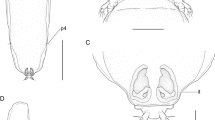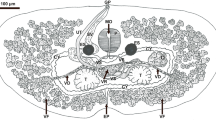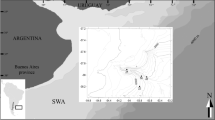Abstract
This study describes the fine structure of the germinal mass in daughter rediae of Tristriata anatis. The germinal mass consists of undifferentiated cells, germinal cells and supporting cells and contains numerous cercarial embryos up to tail bud stage. Supporting cells and their outgrowths form a tight meshwork of the germinal mass. In its basal part, this meshwork serves as scaffolding for undifferentiated and germinal cells, naked cell aggregates and early germinal balls. More mature embryos are located apically. The hypertrophied supporting tissue appears to be involved in an intensive transport of substances, as indicated by abundant gap junctions between cell outgrowths and numerous pinocytotic vesicles and microtubules in their cytoplasm. Germinal cells contain annulate lamellae and the nuage, typical organelles of animal oocytes. In young rediae containing embryonic cercariae at the tail bud stage, the supporting tissue starts to degenerate in the apical part of the germinal mass, and a primordial brood cavity emerges though it develops fully only in mature rediae containing late embryonic cercariae. An unusual feature of the germinal mass in T. anatis rediae is an enhancement of the embryo brooding function. At the same time, the performance of this function by the brood cavity is reduced. This is the first time such a redistribution of the embryo brooding function between the germinal mass and the brood cavity has been reported.




Similar content being viewed by others
References
Ataev GL (2017) Reproduction of trematode partenitae: review of main theories. Nauka, Saint Petersburg
Awad A, Probert A (1990) Scanning and transmission electron microscopy of the female reproductive system of Schistosoma margrebowiei Le Roux, 1933. J Helminthol 64(3):181–192. https://doi.org/10.1017/S0022149X00012153
Brehm K (2010) Echinococcus multilocularis as an experimental model in stem cell research and molecular host-parasite interaction. Parasitology 137:537–555. https://doi.org/10.1017/S0031182009991727
Cheng TC, Bier JW (1972) Studies on molluscan schistosomiasis: an analysis of the development of the cercaria of Schistosoma mansoni. Parasitology 64:129–142. https://doi.org/10.1017/S003118200004470X
Cifrian B, Martinez-Alos S, Gremini V (1993) Ultrastructural and cytochemical studies on the germarium of Dicrocoelium dendriticum (Plathelminthes, Digenea). Zoomorphology 113:165–171. https://doi.org/10.1007/BF00394857
Cort WW, Ameel DJ, Van der Woude A (1948) Studies on germinal development in rediae of the trematode order Fasciolatoidea Szidat, 1936. J Parasitol 34:428–451. https://doi.org/10.2307/3273607
Cort WW, Ameel DJ, Van der Woude A (1954) Germinal development in the sporocysts and rediae of the digenetic trematodes. Exp Parasitol 3:185–255. https://doi.org/10.1016/0014-4894(54)90008-9
Cribb TH, Bray RA (2011) Trematode families and genera: have we found them all? Trends Parasitol 27(4):149–154. https://doi.org/10.1016/j.pt.2010.12.008
Cribb TH, Bray RA, DTJ L, Pichelin S, Herniou EA (2001) The Digenea. In: DTJ L, Bray RA (eds) Interrelationships of the Platyhelminthes. Taylor and Francis, London, pp 168–185
Cribb TH, Bray RA, Olson PD, Littlewood DT (2003) Life cycle evolution in the Digenea: a new perspective from phylogeny. Adv Parasitol 54:197–254. https://doi.org/10.1016/S0065-308X(03)54004-0
Dobrovolskij AA, Ataev GL (2003) The nature of reproduction of trematodes rediae and sporocysts. In: Combes C, Jourdane J (eds) Taxonomy ecology and evolution of metazoan parasites, vol I. PUP, Perpignan, pp 249–272
Dobrovolskij AA, Galaktionov KV, Muhamedov GK, Sinha BK, Tihomirov IA (1983) Parthenogenetic generations of trematodes. Trudy Leningradskogo obshchestva estestvoispytateleǐ (Transactions of the Leningrad Society of Naturalists) 82:1–108 (in Russian)
Eckelbarger KJ (2005) Oogenesis and oocytes. Hydrobiol 535/536:179–198. https://doi.org/10.1007/s10750-004-4397-y
Extavour CG, Akam M (2003) Mechanisms of germ cell specification across the metazoans: epigenesis and preformation. Development 130:5869–5884. https://doi.org/10.1242/dev.00804
Galaktionov KV (2016) Evolution and biological radiation of trematodes: a synopsis of ideas and opinions. In: Galaktionov KV (ed) Coevolution of parasites and hosts. (Proceedings of the Zoological Institute of the Russian Academy of Sciences, 320, Supl. 4). Zoological Institute Publ, St. Petersburg, pp 74–126 (in Russian)
Galaktionov KV, Dobrovolskij AA (2003) The biology and evolution of trematodes. Kluwer Academic Publishers, Dordrecht
Gonchar A, Galaktionov KV (2017) Life cycle and biology of Tristriata anatis (Digenea: Notocotylidae): morphological and molecular approaches. Parasitol Res 116:45–59. https://doi.org/10.1007/s00436-016-5260-6
Grant WC, Harkema R, Muse KE (1977) Ultrastructure of Pharyngostomoides procyonis Harkema 1942 (Diplostomatidae). II. The female reproductive system. J Parasitol 63:1019–1030. https://doi.org/10.2307/3279837
Hanna REB, Moffett D, Forster FI, Trudgett AG, Brennan GP, Fairweather I (2016) Fasciola hepatica: a light and electron microscope study of the ovary and of the development of oocytes within eggs in the uterus provides an insight into reproductive strategy. Vet Parasitol 221:93–103. https://doi.org/10.1016/j.vetpar.2016.03.011
Herber EC (1942) Life history studies on two trematodes of the subfamily Notocotylinae. J Parasitol 28:179–196. https://doi.org/10.2307/3272771
Isakova NP (2011) Germinal mass of the rediae of Trematoda. Parazitologiya 45:358–366 (In Russian)
Klag J, Niewiadomska K, Czubaj A (1997) Ultrastructural studies on the sporocyst wall of Diplostomum pseudospathaceum Niewiadomska, 1984 (Digenea, Diplostomidae). Int J Parasitol 27:919–929. https://doi.org/10.1016/S0020-7519(97)00063-5
Kniskern VB (1952) Studies on the trematode family Bucephalidae Poche, 1907. II. The life history of Rhipidocotyle septpapillata Krull, 1934. Trans Am Microsc Soc 71:317–340. https://doi.org/10.2307/3223462
Kulkarni A, Extavour CG (2017) Convergent evolution of germ granule nucleators: a hypothesis. Stem Cell Res 24:188–194. https://doi.org/10.1016/j.scr.2017.07.018
Littlewood DTJ (2006) The evolution of parasitism in flatworms. In: Maule AG, Marks NJ (eds) Parasitic flatworms: molecular biology, biochemistry, immunology and physiology. CAB International, Wallingford, pp 1–36
Littlewood DTJ, Bray RA, Waeschenbach A (2015) Phylogenetic patterns of diversity in cestodes and trematodes. In: Morand S, Krasnov BR, DTJ L (eds) Parasite diversity and diversification: evolutionary ecology meets phylogenetics. Cambridge University Press, Cambridge, pp 304–319
Matricon-Gondran M (1971) Origine et différenciation du tégument d'un trématode digénétique: étude ultrastructurale chez Cercaria pectinata (larve de Bacciger bacciger, Fellodistomatidés). Z Zellforsch 120:488–524. https://doi.org/10.1007/BF00340586
Morozova KN, Gubanova NV, Kiseleva EV (2005) Structural organization and possible functions of annulate lamellae. Tsitologiya 47:667–678 (In Russian)
Orido Y (1987) Development of the ovary and female reproductive cells of the lung fluke, Paragonimus ohirai (Trematoda: Troglotrematidae). J Parasitol 73:161–171. https://doi.org/10.2307/3282362
Podvyaznaya IM (2007) An ultrastructural study of reproduction in the sporocysts of Prosorhynchoides gracilescens (Digenea: Bucephalidae). Parasitol Res 101:35–42. https://doi.org/10.1007/s00436-006-0443-1
Podvyaznaya IM, Galaktionov KV (2008) An ultrastructural study of the early cercarial development in Prosorhynchoides borealis (Digenea: Bucephalidae) with special reference to formation of the primitive epithelium. J Helminthol 82(2):101–108. https://doi.org/10.1017/S0022149X08890803
Podvyaznaya IM, Galaktionov KV (2014) Trematode reproduction in the molluscan host: an ultrastructural study of the germinal mass in the rediae of Himasthla elongata (Mehlis, 1831) (Digenea: Echinostomatidae). Parasitol Res 113:1215–1224. https://doi.org/10.1007/s00436-014-3760-9
Pollard TD, Earnshaw WC, Lippincott-Schwartz J, Johnson GT (2017) Cell biology. 3rd edn. Elsevier, Philadelphia
Rees G, Day MF (1976) The origin and development of the epidermis and associated structures in the cercaria of Cryptocotyle lingua (Creplin) (Digenea: Heterophyidae) from Littorina littorea (L.). Proc Roy Soc Lond B 192:299–321. https://doi.org/10.1098/rspb.1976.0015
Reuter M, Kreshchenko N (2004) Flatworm asexual multiplication implicates stem cells and regeneration. Can J Zool 82:334–356. https://doi.org/10.1139/z03-219
Saffman EE, Lasko P (1999) Germline development in vertebrates and invertebrates. Cell Mol Life Sci 55:1141–1163. https://doi.org/10.1007/s000180050363
Scott CC, Vacca F, Gruenberg J (2014) Endosome maturation, transport and functions. Semin Cell Dev Biol 31:2–10. https://doi.org/10.1016/j.semcdb.2014.03.034
Skála V, Bulantová J, Walker AJ, Horák P (2014) Insights into the development of Notocotylus attenuatus (Digenea: Notocotylidae) in Lymnaea stagnalis: from mother sporocyst to cercariae. Parasitol Int 63:94–99. https://doi.org/10.1016/j.parint.2013.09.009
Stunkard HW (1966) The morphology and life-history of Notocotylus atlanticus n. sp., a digenetic trematode of eider ducks, Somateria mollissima, and the designation, Notocotylus duboisi nom. nov., for Notocotylus imbricatus (Looss, 1893) Szidat, 1935. Biol Bull 131:501–515. https://doi.org/10.2307/1539989
Stunkard HW (1967) The morphology, life-history, and systematic relations of the digenetic trematode, Uniserialis breviserialis sp. nov., (Notocotylidae), a parasite of the bursa Fabricius of birds. Biol Bull 132:266–276. https://doi.org/10.2307/1539894
Voronina E, Seydoux G, Sassone-Corsi P, Nagamori I (2011) RNA granules in germ cells. Cold Spring Harb Perspect Biol 3:a002774. https://doi.org/10.1101/cshperspect.a002774
Wang B, Collins JJ, Newmark PA (2013) Functional genomic characterization of neoblast-like stem cells in larval Schistosoma mansoni. elife. https://doi.org/10.7554/eLife.00768
Žd’árská Z (1995) Ultrastructure of the primitive epithelium of Echinostoma revolutum (Digenea: Echinostomatidae) cercaria. Folia Parasitol 42:266–268
Acknowledgements
We are grateful to Natalia Lentsman for her help with the translation of the MS into English. We would like to thank the reviewers for their valuable comments and suggestions. Scientific research was performed using equipment of the “Taxon” Research Resource Center (http://www.ckp-rf.ru/ckp/3038/) of the Zoological Institute of the Russian Academy of Sciences (St. Petersburg).
Funding
This work was supported by the Russian Foundation for Basic Research (Grant No 16-04-00753) and by the programme of the Russian Academy of Sciences of the Zoological Institute No. АААА-А17-117030310322-3.
Author information
Authors and Affiliations
Corresponding author
Additional information
Section Editor: David Bruce Conn
Rights and permissions
About this article
Cite this article
Podvyaznaya, I.M., Galaktionov, K.V. Reproduction of trematodes in the molluscan host: an ultrastructural study of the germinal mass and brood cavity in daughter rediae of Tristriata anatis Belopolskaia, 1953 (Digenea: Notocotylidae). Parasitol Res 117, 2643–2652 (2018). https://doi.org/10.1007/s00436-018-5956-x
Received:
Accepted:
Published:
Issue Date:
DOI: https://doi.org/10.1007/s00436-018-5956-x




